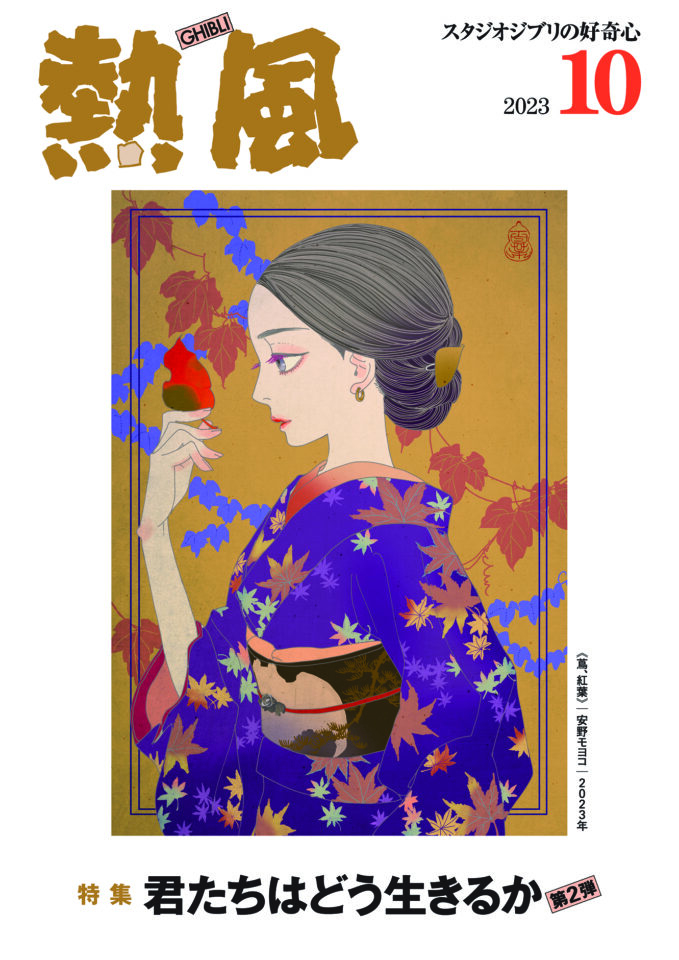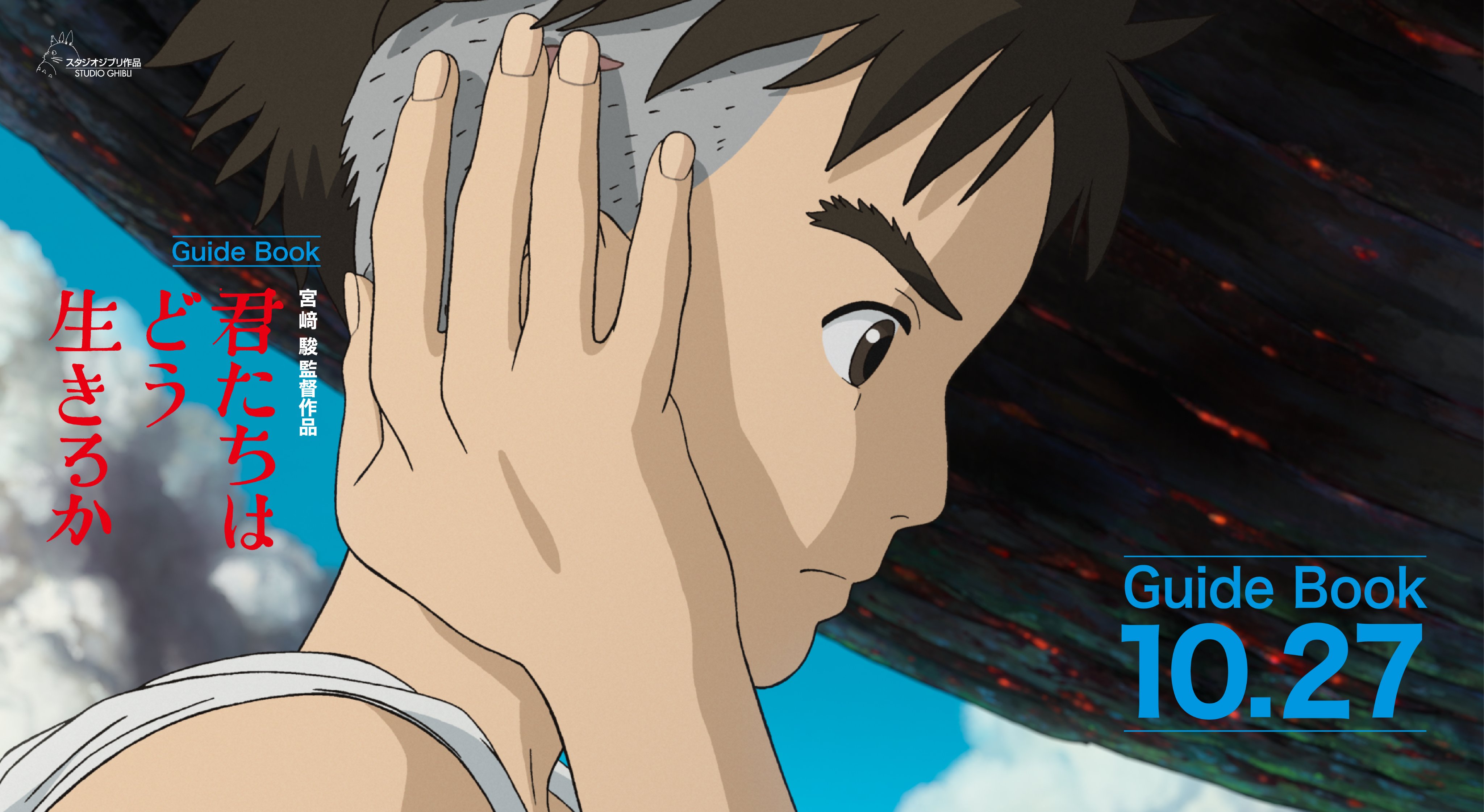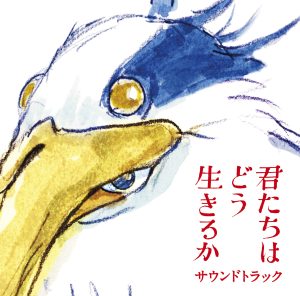Posted on 2022/08/18
新日本フィルハーモニー交響楽団の2023/2024シーズンプログラムが発表されました。2020年9月Composer in Residence and Music Partnerに就任した久石譲です。昨シーズンに続いて定期演奏会に複数回登場します。そのなかの一公演になります。 “Info. 2023/09/09,11 「久石譲指揮 新日本フィルハーモニー交響楽団 定期演奏会 #651」開催決定!! 【9/11 update!!】” の続きを読む
Posted on 2022/08/18
新日本フィルハーモニー交響楽団の2023/2024シーズンプログラムが発表されました。2020年9月Composer in Residence and Music Partnerに就任した久石譲です。昨シーズンに続いて定期演奏会に複数回登場します。そのなかの一公演になります。 “Info. 2023/09/09,11 「久石譲指揮 新日本フィルハーモニー交響楽団 定期演奏会 #651」開催決定!! 【9/11 update!!】” の続きを読む
Posted on 2023/09/08
久石譲指揮#651定期演奏会アーカイブ配信
2023年9月9日(土)すみだトリフォニーホール、9月11日(月)サントリーホールにて、久石譲の世界初演最新作「Adagio for 2 Harps and Strings」を演奏します。ホールご鑑賞用チケットの販売は終了しておりますが、多くのお客様からのご要望にお応えして、この度アーカイブ配信が決定いたしました。 “Info. 2023/09/16 「久石譲指揮 新日本フィル 第651回定期演奏会」アーカイブ配信決定” の続きを読む
Posted on 2022/12/13
2022年12月13日、2023年東宝配給作品ラインナップ発表会見が都内で行われ、スタジオジブリの宮崎駿監督の新作「君たちはどう生きるか」が、2023年7月14日に公開されることが発表されました。あわせて、宮崎監督直筆のキャラクターデザインされたポスタービジュアルが公開されました。 “Info. 2023/07/14 映画『君たちはどう生きるか』(監督:宮﨑駿)公開決定!! 【9/7 Update!!】” の続きを読む
Posted on 2023/09/02
2023年12月27日、「久石譲×関西フィルハーモニー管弦楽団 大阪特別演奏会」の開催が決定しました。ジルベスターコンサートともいえる師走に久石譲コンサートが開催されるのは2019年以来の4年ぶりです。関西フィルハーモニー管弦楽団とは2018年以来の共演になります。 “Info. 2023/12/27 「久石譲×関西フィルハーモニー管弦楽団 大阪特別演奏会」開催決定!!” の続きを読む
Posted on 2023/08/29
2023年9月30日~10月30日の一か月間、第36回マカオ国際音楽祭が開催されます。期間中10月20,21,22日の3日間に久石譲が登場します。「久石譲360」と題しスタイルの異なる3つのコンサートを開催します。海外版となる「Music Future」をマカオ管弦楽団と、そして日本での定期演奏会・特別演奏会さながらに日本センチュリー交響楽団と共演します。 “Info. 2023/10/20-22 マカオ国際音楽祭2023「久石譲コンサート」3種3公演 開催決定!!” の続きを読む
Posted on 2023/08/29
米津玄師、宮﨑駿との日々から得た「創作の祝福と呪い」
いまや国民的アーティストとなった、米津玄師。彼が宮﨑駿監督の最新作『君たちはどう生きるか』の主題歌「地球儀」を制作したのは広く知られるところだ。約4年にもわたる制作期間に何があったのか? 巨匠・宮﨑駿と向き合うという一世一代の仕事を終えた現在の心境、そしてこれからの展望とは。窓の外に蝉の声が響く部屋で、目の前に座る米津玄師に尋ねた。 “Info. 2023/08/29 米津玄師、宮﨑駿との日々から得た「創作の祝福と呪い」(GQ JAPANより)” の続きを読む
Posted on 2023/08/26
2023年8月24日、久石譲コンサートがアメリカ・ハリウッドで開催されました。ハリウッド・ボウルは野外音楽堂、共演オーケストラはロサンジェルス・フィルハーモニックです。同オーケストラは毎年夏この場所で演奏会を開催しています。収容人数は約17,500人です。SOLD OUT!! “Info. 2023/08/26 《速報》 「Joe Hisaishi and La mer」久石譲コンサート(ハリウッド)プログラム” の続きを読む
Posted on 2023/08/26
孤独と熱意が人間性を育む――米津玄師が宮﨑駿から受け取ったもの
宮﨑駿監督(82)の最新作『君たちはどう生きるか』が公開されると同時に、米津玄師(32)が主題歌を提供していることが明らかになり、話題を呼んだ。幼少期から宮﨑監督やジブリ作品に多大な影響を受け、音楽を作る上での指針でもあったという。宮﨑監督から何を受け取り、これからどう生きていくのか。(取材・文:長瀬千雅/撮影:秦和真/Yahoo!ニュース オリジナル 特集編集部/文中敬称略) “Info. 2023/08/26 孤独と熱意が人間性を育む――米津玄師が宮﨑駿から受け取ったもの(Yahoo!ニュース オリジナル特集より)” の続きを読む
Posted on 2023/08/23
このレビューは映画公開直後2023年8月に記したものです。それから経て「熱風 2023年10月号」に掲載された久石譲ロング・インタビューからの情報を整理しレビューの一部を修正したところまで。このページは当時の記録としてそのままに残しています。
2024年8月、映画公開から約1年後に改めて本作品の音楽制作過程や楽曲解説はまとめています。『君たちはどう生きるか サウンドトラック』Discページに関連リンクはまとめています。
2023.11.29 update
音楽制作エピソードについて
「熱風 2023年10月号」久石譲ロングインタビューより。映画公開直後に語り尽くされた25ページにわたる貴重な内容です。いくつかポイントをピックアップしています。ぜひオリジナルテキストに触れてみてください。
(サントラレビューも音楽制作エピソードに沿って一部修正しています)
音楽制作エピソードをもとに、誕生日に贈られた曲で映画使用となったのは、「Ask me why」「祈りのうた」「祈りのうた2(サントラ曲名:聖域)」の3曲は確定になります。語られてはいないですが、個人的には「白壁」もそうじゃないかと推察しています。2017年「小さな曲」という三鷹の森ジブリ美術館オリジナルBGMが贈られています。”小さな曲 = Small Song”、毛虫の世界もまた小さい、2017年は毛虫のボロ制作期間中で同年11月完成、翌年3月公開です。「白壁」の原曲はその「毛虫のボロ」エンディング曲です。曲想からみても、ミニマルというよりはメロディ的なフレーズで流れていることも、そう推察する理由の一つです。
もしそうだった場合、映画のために書き下ろしたのではない、すでにある誕生日曲が短編映画に使用された、もともとイメージの源泉は宮﨑監督にありブレもない、初の実例になります。その手ごたえや感触があったからこそ『君たちはどう生きるか』でもセルフ選曲スタイルを確信をもって進めることができた、という見方もできてくるような気もしています。

「それから年が明け、(2022年)1月5日に宮﨑さんが、僕の仕事場に来られました。あの日は宮﨑さんの誕生日で、僕は毎年、曲を書いて二馬力に持って行くんですが、その時に作った曲が、眞人のテーマ曲ともいえる「Ask me why」だった。この段階では、僕は絵コンテも映像も観ていません。でも、宮﨑さんがその曲をすごく気に入られて、後日「宮﨑さんが『これってテーマ曲だよね』と言っていた」ということを伝え聞きました。それを聞いて、しまった、と(笑)。宮﨑さんって刷り込みの人だから、一度曲を聴いて「いい」というスイッチが入ってしまったら変更が利かない。僕自身は、映像を観てからテーマとなる曲を書くつもりだったけれど、こうなっちゃったらもう、戻れない。覚悟を決めました。」
「今回面白かったのは「じゃ、あとはよろしく」と言われたことで、一音楽家として曲を書くことより、ひとつの映画の音楽全体、あるいは音響全体までをまとめなきゃいけないという意識が強まったことです。新たに広がった視野で考えていった時、僕の掌の中にはすでに宮﨑さんに毎年贈ってきた曲が溜まりに溜まっていることに気づいたんです。4、5分以上の曲が14~15曲以上あって、すぐに「この素材を全部使えばいいじゃん」という発想に切り替わった。かなりタイトな制作期間だったにもかかわらず、制作に集中することができた。宮﨑さんが「これってテーマだよね」と言ってくれた曲があったことも心の支えでした。」
(Blog. スタジオジブリ小冊子「熱風 2023年10月号」特集『君たちはどう生きるか』久石譲ロング・インタビュー内容 より抜粋)

▽イントロダクション
▽全体をとおして
▽ミニマルとは
▽ミニマルの達成
▽楽曲ごとに1
▽誕生日に贈られた曲とは
▽楽曲ごとに2
▽交響組曲への道
これまではジブリらしい久石譲を聴いてきた。この映画は久石譲らしい久石譲を聴いている。
宮崎駿監督が映画を作るごとにファン層を広げ次作映画への期待を雪だるま式に膨らませてきたという歴史があるように。ことスタジオジブリ作品の音楽を担当するときの久石譲にも同じ図式が当てはまってしまう。これまで宮崎駿監督と長編映画10作品、短編映画3作品、そして高畑勲監督と長編映画1作品を共に歩んできた40年間だ。最新作は宮崎駿×久石譲の長編映画11作目になる。
楽しみと期待に待つ年月は、今か今かと胸躍らせその膨らみは宝箱の蓋がぶるぶる震えるのを抑える状態だった。そして、想像を超えて裏切ってくれた。一回目の映画鑑賞ですべてわかるわけはない。映像も音楽もはじめまして、ありのままに浴びる瞬間にこそ至福がある。そんななか一回目のファースインプレッションは大切にしたい。これまでのジブリらしい久石譲はあまり見当たらなかった。ロマンティックなメロディもダイナミックなオーケストラサウンドもついぞ出てこない。一方で、久石譲音楽と共に歩んできたファンからすると、この映画は久石譲らしい久石譲を聴いている。感じた第一印象はこの先も揺らぐことはないだろう。
宮崎駿監督が絵や物語でむき出しの宮崎駿を見せてくれたように、久石譲もまた音楽でむき出しの久石譲を見せてくれた。宮崎駿監督の果てしない創造力に共振するように、久石譲は久石メロディを開花させ久石ブランドを進化させてきた。そういう音楽活動の歴史だと言い切ってもいい側面がたしかにある。そして、本作でアイデンティティがぶつかり合うことになった。久石譲の音楽ルーツはメロディメーカー以前に現代音楽でありミニマル・ミュージックだ。だから、本作はミニマルだ。
スタジオジブリ作品は映画も音楽もレガシー。築きあげられてきたエンターテインメントと届けられたギフトを振り返ればそう異論は起こらないだろう。そしてここに、スタジオジブリのレガシーはまたひとつ高みに立ったことを、僕らは力いっぱい目の当たりにすることになる。映像も音楽も新しさに満ちていた。持てる技炸裂のなか、ここらで総括しましょう的な集大成にはなっていない。そこに守りの姿勢はない。漲るエネルギーと若々しさに、映画の感動とはまた別の勇気ももらえた。
上映時間124分、サウンドトラック69分、本編の約半分に音楽がついていることになる。3つの視点から補完すると、ひとつサウンドトラック収録曲に複数回使用はない、曲まるごとも曲の一部でも。ひとつサウンドトラックに未収録曲はない。ひとつサウンドトラックに未使用曲はある。つまりは、99%映画本編に沿って曲順も曲尺もサウンドトラックに音源化されている。残りの1%は映画本編には使われなかった楽曲の一部が収録されていることだ。詳細は楽曲ごとの項で紐解きたい。
演奏は、Future Orchestra Classics。久石譲のもとに集う若手トップクラスの精鋭からなる招集型オーケストラだ。過去に音源化されているもの(かつクレジット確認できるもの)から『海獣の子供』(2019)『映画 二ノ国』(2019)も、招集型で音楽収録されている。ただしクレジットは各奏者一覧でメンバーも都度異なる。本作で初めてFuture Orchestra Classics(FOC)の名札でクレジットされた。またFOCコンサートマスター近藤薫氏ではなくゲストコンサートマスター郷古廉氏になっている。中心となるメンバーと時々のスケジュールなどで輪に加わるメンバーとで構成されていると推察する。もっとも大切なのは、久石譲が表現したい音を出せるオーケストラ、表現したい音楽の編成(室内オーケストラ)で臨める、指揮者と演奏者の音楽共同体として進化をつづけていることだ。2016年に発足したFOC(旧NCO)はクラシックの演奏会やアルバムで高い評価を得ており、久石譲新作などの現代作品まで、常に現代的なアプローチで研鑽し精力的に活動している。それは、本作の音からも聴きとれるはずだ。
演奏は、久石譲本人によるピアノ。前述より『海獣の子供』『映画 二ノ国』の音楽は、オーケストラは同じスタイルをとりながらも、ピアノ演奏は他者によるものであった。ピアノの使われ方だろうか、求めたタッチやニュアンスだろうか。両作ともにメロディアスな曲もミニマルな曲もある。今回ふと思ったことだが、とりわけ近年において区別しているのかもしれない。宮崎駿監督作品に久石譲ピアノはなくてはならない。繊細な音の強弱やテンポの揺らぎからくる久石譲のピアニズムは、映像がなくてもジブリをイメージしてしまうほど記憶のなかで結びつけられている。『海獣の子供』も『映画 二ノ国』もアニメーション映画だった。『君たちはどう生きるか』でピアノの鳴っていない曲はほぼない。久石譲のシグネチャーを刻印している。
【自身の少年時代を重ねた自伝的ファンタジー映画】(パンフレット 作品解説より)とあるように、主人公は宮崎駿監督を強く投影している。久石譲も【今回は、オケ(オーケストラ)ではなく、ピアノ一本とか、シンプルに主人公の心に寄り添ってつくったほうが良いかもしれませんね】(スタジオジブリ公式SNSより)とあるように、久石譲の紡ぐピアノにレンズを絞っていく。主人公と同じようにずっと物語にいて常に寄り添っている。
録音は、2023年1月21日頃から2月1日頃にかけて行われているようだ。公式SNSの情報や投稿日をもとにしている。CDライナーノーツには録音スケジュールのクレジットはなかったため、下の公式情報をまとめたものから参考にしている。
ミニマル・ミュージックとは、短いフレーズやリズムを微細に変化させながら繰り返す音楽のこと。前衛音楽として始まり、現在はジャンルの垣根を越えて定着している。「ミニマルの手法」「ミニマル・エッセンス」「ミニマル・ミュージックの要素」などと説明されることもあるように、ポップスからクラシックまで定義はより広がりをみせている。本作におけるミニマルも広義だ。本来の反復やズレはもちろん、音楽の素材が最小(ミニマル)であることもポイントだ。フレーズ(音型)、編成(楽器)、曲想(構成)、これら最小に組み立てられている。つまるところ徹底的にミニマルなのだ。必要最低限に削り落された音のコアによって、研ぎ澄まされた音楽が強く輝き、観る人聴く人のイメージネーションを最大限に広げてくれる。
ここまでミニマルに貫けたわけを別角度から眺めてみる。2019年に米津玄師氏への主題歌オファーが内定した時点で、その布石はあったのかもしれない。久石譲は主題歌候補になりそうなメロディを気にすることもなく、本編音楽のメロディ楽曲とミニマル楽曲のバランスなど考慮しなくてもいい音楽設計が見えてきた可能性だ。ゆえにミニマルのアプローチを一貫してできたという見方もできてくる。音楽の方向性が決まったのは2021年秋頃とある。2022年7月頃から本格的な音楽制作に入っている。ここで言う本格的なとは、出来上がったラッシュ映像を見ながらその具体的な楽曲づくりのこと。過去より慣例となっていたイメージアルバム的な音楽制作やその過程については『風立ちぬ』『かぐや姫の物語』そして『君たちはどう生きるか』と明るみになっていない。
もうひとつの布石もある。2020年以降、久石譲が映画音楽を担当したのは『赤狐書生 (Soul Snatcher)』、『川流不“熄”(A Summer Trip)』(未音源化)という海外映画二作品だけだ。多くの創作活動を自作品(交響曲・室内楽)に傾けている。振り返って2013年『風立ちぬ』『かぐや姫の物語』の頃はその前後にも多くの映画音楽を担当していた状況からみても、その創作環境は大きく変容した。2014年以降「クラシックに籍を戻す」とし有言実行の活動を作曲と演奏会と続けている。2021年からは「自分はミニマリストだ」という積極的な発言もまた顔を出す。つまりは、本作がミニマルで貫くことは、あるいは必然だったのかもしれない。
重ねる布石もある。『海獣の子供』(2019)はミニマル色の強い音楽づくりがされている。本作の音楽のいくつかを聴きながら連想するのは自然なことだろう。『Deep Ocean』(2016/2017/2023・未音源化)、『ad Universum』(2018・未音源化)、『Xpark』(2020・未音源化)などもアプローチは同じだ。久石譲は「エンターテインメントでもミニマルのスタイルで貫けるときにはブレずにやる」と語っている近年の作品群だ。言わずもがな『君たちはどう生きるか』はその群を抜いてオンリー・ミニマルだ。
堅苦しいことは一旦置いておいて。よくまあこんなにもミニマルなフレーズがあちこち飛び出すからすごい。映画鑑賞はもちろんサウンドトラック盤に集中して聴いたとしても、ミニマルな曲たちをきれいに整理するのは大変だ。シンプルなはずなのに覚えるのは容易ではない。普通なら一つの映画に半分も決してない、1,2曲あるかもしれない、3割ミニマルで占めてたらかなり目立つ。アート映画ならまだしもエンターテインメント映画ならなおさらだ。築きあげてきた自作品の成果をも注ぎ込むかのように、バラエティ豊かなミニマルに溢れている。映画音楽家久石譲と現代作曲家久石譲は、長年の並走を経ていよいよ交わり大きなひとつのオリジナリティに膨張しようとしている、のかもしれない。
その一。短いフレーズの微細な変化によって、独特のハーモニーがうまれる。瞬間的な長調と短調の響きが変化をくり返したりと全体には言い表しづらい独特な印象を醸し出す。楽しい悲しいとも押しつけることのない俯瞰的な視点をもつ曲となる。観る人聴く人のタイミングや環境によってその人色に染まってくれるミニマル。
その二。スタジオジブリ作品で日本を舞台としたのは『となりのトトロ』『もののけ姫』『千と千尋の神隠し』『崖の上のポニョ』『風立ちぬ』『かぐや姫の物語』(音楽:久石譲)だ。いくつのメロディがあっていくつのミニマルがあっただろう。本作で聴かれるミニマルは日本的なものもあれば西洋的なものも混在している。ことオリエンタルなミニマリズムでいうと、久石譲はかねてからそのパイオニアの一人として現在まで進化を続けている。【もっともナショナルなものこそインターナショナルになりうる】(宮崎駿)と言う、【ドメスティックはインターナショナルになる】(久石譲)と言う。ずっと貫いてきた人だ。今や日本人のミニマル作曲家、フロントランナーとして世界へ向けて発信している稀有な存在でもある。
その三。現実世界と異界を行き来する物語のどちらにもミニマルで書かれている。例えば現実世界はメロディ中心に異界はミニマルにと書きわける方法論もあるだろう。ミニマルで貫くことで空間も時間の流れも異なるどちらの世界にもリアリティを持たせている。そうして、ファンタジーをミニマルで成立させてしまっているこの達成は大きい。ミニマル・ミュージックはどこで始まってもいいし終わってもいい、あるいは終わりを持たなくてもいい。本作といっしょ、ミニマル音楽は時空を越えた永遠の世界を描いているのだ。
その四。映画公開後、公式関連のラジオ番組をいくつか聴いた。番組BGMはもちろんこのサウンドトラックからだ。けっこう会話に耳を集中できるのだ。もしも、これが『千と千尋の神隠し』の話題になって「ふたたび」がBGMで流れ出しでもしたらそうはいかない。話を追っているのか、メロディを追っているのか、映画シーンの記憶を追っているのか、急に気もそぞろだ。僕らはずっと、あの美しいメロディが映像や物語を引き立たせていると思っていた。本作は新しい扉を開いた。あの曲とあのシーンという結びつきを越えて、ミニマルな曲たちが有機的に自由に結びつきながら映画の世界観を大きくつくっている。
映画ストーリーにはなるべく触れずに音楽中心に進めている。気をつけたというよりも音楽に重きを置いたファンだからしょうがない。それしかできない。映像や物語の考察はあまたのファンや研究家の皆さんに委ねて、その鋭い洞察のひとつひとつに唸りたい。こちらは音楽の場所から楽しみながら記していく。さあ、聴き解いていこう。(私的)徹底解説のはじまり。
1.Ask me why(疎開)
12.Ask me why(母の思い)
34.Ask me why(眞人の決意)
本作のメインテーマにあたる楽曲で、オープニングタイトルから本編終盤まで大切なシーンに流れている。原点回帰と言うにふさわしいと思うのは、そのシンプルでまっすぐな曲想だ。メロディも、和音も、コード進行も、すべてが直球で逆に驚いたくらいだ。「あの夏へ」や「アシタカとサン」を思い出してほしい。そこには久石譲らしい四和音ら複雑に音を重ねた神秘的なハーモニーに、新しくて懐かしい旋律に、メロディを自由に歌わせる予想を超えたコード進行に、あるいは高揚する転調にとファンの心をとろけさせてきた。それに比べると耳のいい人なら聴いてすぐ弾けてしまうくらい潔い、初期のピアノ曲に通じるものがあるのかもしれない。シンプルゆえに無垢すぎる。シンプルゆえに強い。
さて、「Ask me why」をもって「ミニマル」とするかとなると、ちょっとした混乱と論争に発展しそうだ。ほかの多くの曲の定義が揺らぎかねない。ソとレだけで作られた短いモチーフがくり返しながら変化しているメロディ、最小な和音と和声、そういった捉え方をするなら「シンプルに、ミニマルに」とは言えるだろう。前奏や間奏も徹底的にソとレをくり返す曲バージョンもある。森を見るようにサウンドトラック全体から、木を見るようにこの一曲をと遠近しながら眺めたらなら、ミニマルで貫いたと賛同するだろう。でも、この曲はミニマルなんですか?と誰かに聞かれたら違うと答える自分がいる。結局のところ、定義なんて後からついてくるのだ。ミニマル・ミュージックは現代音楽だけれど、現代から見るとバッハのピアノ曲もここミニマルだよねとか、ベートーヴェンの交響曲もここなんてミニマルの走りだよねなんて言わたりするのだ。だから、キリキリすることはない。曲を楽しめばいい。
宮崎駿監督の誕生日にプレゼントされた曲だ。おそらくオリジナルはピアノ曲として約5分ほどで仕上げられていると思う。本作への使用にあたってシーンに合うように手が加えられている。結果的に曲パートを一部抜き取ったような短い曲尺になっているのは残念だ。「久石譲&ワールド・ドリーム・オーケストラ 2023」(WDO2023)でサプライズ・アンコール曲となったが、ピアノ曲のほうをベースにしているのかもしれない。くり返す構成ではあったが間奏もあって長めに披露されていた。
新しい服を買ったとき、自分の思う最良な組み合わせがきっとある。買ったシャツに合うのは、この形と色のパンツかな、重ね着するならこれかな。でもこの組み合わせもいいかもといくつかその変化を試しながら、やっぱりこれがベストかなと最終的に落ち着くコーディネートがある。映画公開後にスタジオジブリ公式SNSで公開された久石譲の演奏動画は、ちょっとしたフレーズや伴奏に変化があった。今は弾くたびに変わっているのかもしれない。「風の伝説」「あの夏へ」「人生のメリーゴーランド」も曲の誕生からコンサートでメロディや伴奏の装飾が変わり、最終的には今久石譲の思うベストなフォルムに落ち着いている。そういうこと、そんな感じ。
おやっと思ったところもある。久石譲の曲には、いわゆるポップスの歌詞をのせる節まわしのような同音連打のメロディラインはあまりない。すぐに思い浮かんだのは「あの夏へ/One Summer’s Day」くらいなもので、あとは鍵盤のあいだを広く大きく動きまわる旋律が圧倒的に多い。メロディのはじまるソの音の連打は、まるでノックしているように聴こえてくる。心の扉をたたく”Ask me why”、運命の扉をたたく”Ask me why”。本編に沿うと、meは時々で主人公であっても母であってもいい。「Ask me why/理由を聞いて」の直訳だが、「(If you) ask me why/もしなぜって聞かれたら/もし私に尋ねられたら」「If you ask me/私に言わせれば、私の考えでは」など含蓄のある日常的フレーズが出てくる。この曲は扉をたたく力だと思っている。
2.白壁
この曲は、短編映画『毛虫のボロ』(2018・未音源化)のエンディング曲だ。音楽を担当した久石譲によるピアノ曲だが本編はこの1分間に満たない一曲しか使われていない。本作のためにピアノも弾きなおしている。曲名が「白壁」となっているのは本編シーンに由来してと思われる。
なぜこの曲を転用したのか? 監督や久石譲の提案や真意はわからないため、関連づけのみ考察する。『毛虫ボロ』のあらすじを一口に言うと、卵からかえるところから、外の世界へ踏み出していく物語だ。考察をはじめると、見るもの触れるものすべてが新しい世界であり、小さな毛虫にとって大きな外界は試練の連続でもある。未知の大冒険だ。行く先々でいろいろな試練が待ち受けている毛虫の移動と、主人公の疎開という移動そこから起こる物語を暗示しているのではないか。新しい世界、そこは祝福されたものではないかもしれない。『毛虫のボロ』のエンディングにも流れるメランコリックなこの曲は、小さな毛虫が外界に立ち向かっていった先をハッピーエンドともバッドエンドとも決めない絶妙なシーソーの上に立つ一曲だ。仮に宮崎駿監督が気に入っていたとしても、作曲者の久石譲が気に入っていたとしても、なんら不思議のない納得の選択だと思う。
2001年三鷹の森ジブリ美術館の開館以来、久石譲は宮崎駿監督の誕生日にピアノ曲をプレゼントしている。毎年ではないが近年は更に恒例になっていて、これまでに約12曲くらい献呈している。それらは「三鷹の森ジブリ美術館オリジナルBGM」として館内で使用されているはずだ。特定の場所や時期にしか聴けないものもあるだろう。土星座でしか聴けない短編映画ラインナップのBGMで使われているものもあるだろう。これも常時ではない。
「Ask me why」は2020年に贈られた曲とスタジオジブリ公式SNSからも推察できる 2022年に贈られた曲と久石譲インタビューからわかる。そのエピソードからは【歌のようにお経のようにつぶやいているものを書きたい/アイデアは半年以上前から持っていた/1日ぐらいで作った】と明かされている。すでに映画に向けて動いている時期でもあり、久石譲のどこか頭の片隅にイメージが彷徨っていたとしても不思議じゃないし、あるいはまっさらに書き下ろしたものかもしれない。
「祈りのうた」は2015年に贈られた曲だ。「祈りのうた for Piano」として『Minima_Rhythm II ミニマリズム 2』(2015)に収録された。そのピアノ+弦楽合奏+チューブラー・ベルズ版は「久石譲&ワールド・ドリーム・オーケストラ 2015」(WDO2015)で世界初演、『The End of the World』(2016)に収録された。大きく繰り返す構成ではあるが、オリジナルは約6-7分の楽曲だ。本作のために録り直して必要な約4分にまとめられている。
「白壁」は誕生日に贈られた曲か? この疑問がふと浮かんでくる。どれだけ考察を尽くしても結局は公式解答をもってしか答え合わせができない。だからうだうだ書くことはやめる。三鷹の森ジブリ美術館オリジナルBGMとして贈られた曲で、本作使用にあたって曲名をそのまま継承しているのは「Ask me why」と「祈りのうた」の2曲だけだ。もし「白壁」(毛虫のボロBGM)ほかサウンドトラック収録曲にほかにも誕生日に贈られた曲があるとしたら、曲名が変わっているだろうということは言える。「聖域」は?とか好奇心は尽きない。
⇒久石譲が語った音楽制作エピソードをもとに、誕生日に贈られた曲で映画使用となったのは、「Ask me why」「祈りのうた」「祈りのうた2(サントラ曲名:聖域)」の3曲は確定。ただし、”これで全部”という言い方もまたしていない点にも留意したい。
3.青サギ
5.青サギⅡ
8.青サギⅢ
10.青サギの呪い
ミとシ。4度の二音からなる最もミニマル(最小)なテーマだ。鳥らしい鋭さや俊敏さ、そこに不穏さやつかめなさまでも漂っている。「青サギⅢ」二音が音の高さを変えながら豊かに展開していくさまや、冒頭のバスクラリネットかバスーンがまるで鳥の喉仏が鳴っているような効果もあっておもしろい。「青サギの呪い」中間の躍動するパートは自作品「I Want to Talk to You」(2021・未音源化)の展開部を思わせる。ミニマルらしい一瞬にして切り替わるハーモニーの変化だ。FOCのソリッドでノンビブラートな演奏も光っている。4曲を並べてみると、少しずつ物語に深く関わっていくこと、主人公にとっても意識する存在へと膨らんでいることを、曲想が膨らみをます過程からも感じることができる。
また4度の二音からなるテーマは『海獣の子供』(2019)琉花のモチーフもそうだ。サウンドトラックのいろいろな楽曲の中に織り込まれている。忘れてはいけない、『千と千尋の神隠し』(2001)湯婆婆のモチーフもそうだ。ソとレの4度の二音だ。鳥に変身して空を飛ぶ。
話は横道に大きくそれる。なぜこの二音なのか、ずっと迷走していた。アオサギの学名・英語名などを調べていた。バッハは自分の名前を曲に刻印した。BACHでシ♭ラドシの音になる。青サギのテーマは「ミ・シ」=「E・H」で、HはHeronに運よく当てはまってしまったもんだから俄然Eも意味があるのではと思い始めてしまった。迷走のままだ。でも調べるなかでアオサギの【意識と潜在意識を行き来する】といったスピリチュアルなエピソードや、そのほか縁起の良い象徴とされている由来を持っていることもいくつかわかった。
主人公のテーマともいえる「Ask me why」はト長調だ。青サギのテーマはホ短調だ。このふたつは同じ調号をもつ平行調だ。わかりやすく上手に言えないが、楽譜にシャープひとつの音階でコード進行上も登場しやすい。ト長調の曲で間奏はホ短調そしてまたト長調に戻る、そんなスムーズにシンプルに進行する曲はバッハ「メヌエット ト長調 BWV Anh.116」などある。言ってしまったら、とてもつながりの深い関係性にある。久石譲という人は論理の人だ。すべてにおいて論理立てできるとは思っていないし、そこには到底言語化できない感性や直感もある。でも、なんとなくではしない人だ。
「34.Ask me why(眞人の決意)」ト長調で流れていく曲のアウトロはホ短調になっている。本来は終結部というよりも中間部や間奏として広がっていくパートに相当するだろう。曲想からすると、簡単な道を選ばなかった決意や、新たな試練が待ち構えていることを予感させる。もう一方の見方をするなら、青サギ(ホ短調)との出会いや記憶がしっかり刻まれていること、そんなことまで暗示しているように聴こえてこないだろうか。とてもつながりの深い関係性にあるのだ。
4.追憶
9.静寂
シンプルな単音をくり返す。最小限でありながらピアノにグロッケンやハープといった音色を繊細に編み込んでいる。「追憶」精緻で奥ゆかしいハーモニーを奏でるストリングスは『かぐや姫の物語』(2013)のそれを思わせる。「静寂」できるだけ音数を減らして音と音の間をも聴かせる。『花戦さ』(2017)では、このような静の音楽が一輪挿しのような慎ましさと空間美を表現していた。本作は、息をひそめるシーンで映像と音楽とで観客の集中力を高めている。空気の動きのような音楽、気配を感じて一瞬の動きの変化を逃さぬよう耳を意識をすませる。
6.黄昏の羽根
22.回顧
久石譲らしい曲のひとつだが、ここでも展開や増幅を抑えた構成になっている。『二ノ国 II レヴァナントキングダム』(2018)では、ゲーム音楽ならではのくり返し聴かれることを特徴とした音楽づくりがされている。起承転結の曲ではない、最小限の展開でループできる音楽。そしてもうひとつ、接続的フレーズで曲が終わっていること。本作の多くの曲もしっかりとあとの余韻を残すところまで貢献している。「黄金の羽根」室内楽サイズに近い弦楽のざらざらした音像が、羽根の一本一本その毛並みまで想起させてくれるようだ。「回顧」通常オーケストラサイズに近い。このように音の質感をも絵やシーンの肌ざわりに合わせている。塔にまつわるシーンだ。自作品「交響曲 第2番 第1楽章」(2021)の単一モチーフと同じような運動性をもったフレーズが登場していることもおもしろい。
7.思春期
映画鑑賞の後にサントラを聴いている。このシーンは強い印象を残すところで曲よりも絵を覚えていた。だから、どうしてこんな曲想にしたんだろう?と2回目の鑑賞でチェック項目にもなっていた。転校先での風景だ。時代の軍歌や唱歌のような曲想にすることで、取り巻く環境ふくめて風刺の効いたものにしている。あえて主人公の感情や行動からは一歩引いたものにして絵の衝動とバランスをとったのかもしれない。鮮烈で鋭利なシーンだ。
11.矢羽根
23.急接近
豊かなミニマルだ。『フェルメール&エッシャー』(2012)の品のある室内楽、自作品「Winter Garden」(2014・未音源化)の胸躍る高揚感などが瞬時に駆け巡る。もう少し類を広げていいなら自作品「Viola Saga 第1楽章」(2022)もそうだ、少し明るいミニマルが顔を出す。このタイトルは英雄伝説や長編冒険譚という意味も持たせている。それはさておき、つまり久石譲の作家性が翼を広げた作風が好きなのだ。本作で1,2を争うほど気に入っている曲で、あまりこの指にとまってくれる人はいないかもしれない。しょうがない。
『風立ちぬ』(2013)「紙飛行機」を思い浮かべることもできる。共通点もある。何かを工作している時間が流れている。作って試してうまくいって。その夢中になっているひとときや胸の高鳴りを表現している。そして工作をとおして心をつなげることもまた「紙飛行機」のシーンとの共通点だ。この指にとまってくれる人はちょっとできただろうか。とても惹かれる。
「矢羽根」ちょうど曲の真ん中あたり、カットとシンクロしているわけではないと思うが、強めのピッツィカートが工作でトントン打っているいる音や、はたまたピンと張った弓の具合を確認しているようなシチュエーションまで想像させてくれる。ピッツィカートはヴァイオリンなどピンと張られた弦を指で弾(はじ)いて音を出す。こうやってイマジネーションをどんどん膨らませてくれるからほんとおもしろい。「急接近」少しやわらかい曲調への変化が、距離感や歩み寄りを感じさせてくれてまたいい。もちろんここも工作している。
心躍る勢いで進めてしまうと、『風立ちぬ』「隼班」も工作、設計と連想するなら曲想もまた同じアプローチだ。ミニマル・エッセンスに溢れている。そうして本作との大きな違いも見えてくる。「隼班」もそうだ、ミニマルで展開しながらも、そこへ滞空時間の長い大きな旋律が奏でだす。『海獣の子供』(2019)もそうだ、ストリングスの大きなメロディが登場してくる。本作にはその傾向は全くない。くり返すが徹底的にミニマルだけで貫いている。こういったところからも見えてくる。
13.ワナ
Future Orchestra Classicsの特徴はリズムアプローチがきっちりしていること。もうひとつがノンビブラート奏法だ。ビブラートをかけない、弦を揺らさない、息を震わせない。そうすることで音がまっすぐに伸びる。遠くまで抜ける音像は本作すべての曲でそうだ。演奏は音価もそろえた細心の注意と集中力の塊だ。感情が入ると音符の長さもバラバラになり、ついつい音を震わせて歌ってしまう。その真逆にある。端正な演奏が感情移入をこちら側に委ねている。久石譲ピアノも、楽曲によって情感をもたせるものとやや強めにリリカルにと弾きわけている。現代オーケストラらしいソリッドなアプローチはFOCの美点だ。微細に移り変わっていくグラデーションのようなハーモニーの変化もまた自作品「I Want to Talk to You」(2021・未音源化)や「Viola Saga」(2022)などで磨きをかけている。
14.聖域
15.墓の主
21.別れ
『かぐや姫の物語』(2013)で高畑勲監督がオーダーしたのは【運命を見守る】ような音楽だった。それは【登場人物の気持ちを表現してはいけない/状況につけてはいけない/観客の気持ちを煽ってはいけない】という方向性に集約されていった。「春のめぐり」らその印象的な曲をイメージする人もいるかもしれない。同じような俯瞰さを持ちながら、ここではより威厳や畏敬を感じさせる。
さらに音楽的手法から深い関連性を持つと推察するのは「祈りのうた」だ。ピアノ左手の動きに注目してほしい。一音ずつ隣の鍵盤へ動く順次進行になっている。「聖域」ドシラと3音下がる順次下行の次にドレミと3音上がる順次上行になる。続けてミレド(順次下行)ミファソ(順次上行)と音程を変えてくり返していく。「墓の主」ドシラソファミと大きな順次下行の次にドレミファソラと大きな順次上行になる。それとは別に「別れ」や上2曲の前半部に聴かれる低音は無軌道な動きをしている。ここからイメージできるのは、現実世界とは異なる時間のゆがみや、時間の法則その流れ方の違い。時空が大きく呼吸しているような曲だ。案内人でもあるキリコとのシーンに聴かれる。
16.箱船
スタジオジブリ作品でここまで南国風な音楽を書くのは初めて耳にしたかもしれない。ここからシンセサイザーやエスニックなパーカッションも登場している。ミニマルで貫こうとするとどうしても変化に乏しくなる。アルバム一枚聴いたら全部同じに聴こえた、ミニマル・アーティストにつきまとうあるある。音色や曲想で世界観をカラフルにしているのはさすが、ファンタジーらしさもちゃんとおさえてくる。そういえば、下の世界に吸い込まれていくとき床絵は太陽のモチーフだったような。そういえば、『千と千尋の神隠し』(2001)「神さま達」が船に乗って登場するシーンにも、中低音のボーンと響く打楽器が鳴っていたような。
17.ワラワラ
同じ世界を描いている「箱船」と音色も曲想もつながりがある。楽しいわらべ歌のようなモチーフなのもキャラクターに相応しい。神秘的なオリエンタリズム溢れる曲だ。ボイスキャストの声とは別に曲にもサンプリングボイスが使われている。『となりのトトロ』(1987)のまっくろくろすけはピグミー族の声をエディットしたものだ。ワラワラはどこから来たのだろう。
『となりのトトロ』「メイとすすわたり」、『もののけ姫』「黄泉の世界」、『千と千尋の神隠し』「神さま達」、『ハウルの動く城』「サリマンの魔法陣」、『かぐや姫の物語』「天人の音楽」。久石譲が作品ごとに多彩なサンプリングボイスを込めた曲たちだ。こう見てみると、そこには神聖なもの霊的なものを宿しているように思えてくる。つながって生、生命、魂のようなものを浮き立たせているように思えてくる。『NHKシリーズ 人体III』(1999)もそうだ。サンプリングボイスを登場させるとき、久石譲の流儀がそこにありそうだ。
18.転生
シンセストリングスもなじませながら紡ぐピアノ、久石譲らしい揺らぎのニュアンスとたゆたう調べ。『千と千尋の神隠し』(2001)「6番目の駅」をはじめ相性がいいことはわかっている。きたと耳が喜んでいる。そうは言っても、ありそうでなかった明るくやわらかい響きが心地いい。深呼吸するように演奏も大きな弧を描いている。ストリングスの下から上への二音のくり返しは、高く高く昇っていくことを誘っているようだ。ワラワラのモチーフも登場し、ここまでの3曲はシーンを象徴するように神秘的な音楽に包まれている。
19.火の雨
25.炎の少女
27.回廊の扉
変幻自在な変拍子だ。「火の雨」旋律の動きをパーカッションで重ねている(ストリングスとスネア)。小編成で臨んだときに音像の厚みや立体感を出すためのアクセント術で、自作品「コントラバス協奏曲」(2015)などもっと多彩な打楽器群で盛りだくさんだ。「炎の少女」コーラスは3拍子、オーケストラは4拍子を軸にしている。巧みなポリリズムだ。おもしろいからやってみてほしい。0:09-コーラスに耳を合わせて聴いていくと3拍子のリズムで-0:46まで行けるだろうか。次に同じ0:09-からストリングスに耳を合わせて4拍子で聴いていくと、こっちはわりとすんなり-0:46まで行けそうだ。譜面はどちらの拍子を軸にしているのかわからないけれど、ゴールする地点は同じ。3拍子で聴こうと思ったら、つられたりわからなくなりそうだが、指で三角を描きながらすると、おもしろい躍動感が迫ってくる。火を操るほどのリズムトリックだ。だまし絵で見え方が変わってくるようにどのリズムで聴くかで表情が変わる。(だからほんとやってみてほしい!)。「回廊の扉」ミニマルとはリズムもまたズレたり変化する。ヒミにまつわるシーンだ。
麻衣(久石譲の娘)は『崖の上のポニョ』(2008)の「ひまわりの家の輪舞曲(ロンド)(イメージアルバム)/水中の町(サウンドトラック)」で参加している。リトルキャロルは同作品の「いもうと達(イメージアルバム)」に参加していた。麻衣を中心とした女声コーラスグループで、スタジオジブリ作品の本編音楽としては待望の初参加となった。また久石譲の自作品「I Want to Talk to You」(2022・未音源化)の合唱版も演奏会プログラムに持つ。そのライブ映像は公開されている。美しいコーラスワークをアルバムやコンサートで触れることができる。
20.呪われた海
未使用曲だ。正確に言うと未使用パートも音源化された曲だ。本編に使われているのは冒頭-1:23あたりまで。そして少しカットが進んだあと2:17-endが使われている。中間パートが未使用になっている。もし映画を何回も見ている人なら同じことを思う人もいるかもしれない、仮に一曲そのまま使うとカットと曲のニュアンスが少し合わないように思う。本来そこには別のカットが挟まれていたのか、はたまたイメージアルバムのように長尺で作られた曲想があるのか、興味深い謎がまたひとつ。老ペリカンのシーンだ。呪われた海を表現するのに、使われなかったけれどあったほうがいい、絶対そうだ。『悪人』(2010)や『坂の上の雲』(2009)などにもみられる、抗いようもなく翻弄されてしまう、潜んでいる闇は深い。
使われていないパート、もっとこういうの聴きたいと思ったら『フェルメール&エッシャー』(2012)「Vertical Lateral Thinking」あたりにも手をのばしてほしい。洗練されたミニマルが聴けるはずだ。あるいは極上の小音楽空間へ、現代の最先端の音楽を室内楽やアンサンブルで届けるコンサート「久石譲 presents MUSIC FUTURE」シリーズも、きっと楽器の音をダイレクトに楽しめるはずだ。
24.陽動
28.巣穴
31.隠密
32.大王の行進
「陽動」かわいらしい高音と小さい音の粒。鳥たちのさえずりや群集を思わせるウッドパーカッションも効果的だ。「巣穴」同じモチーフが中音域になる。まるで音の高さと鳥の大きさがリンクしているようでおもしろい。「大王の行進」そうくればどっしり大きい相乗の変化だ。また『映画 二ノ国』(2019)「エスタバニア城」などにもつながる。大王の行進を描いていることはもちろん、そこに王国が築かれているということまでをしっかりイメージさせてくれる曲想だ。インコにまつわるシーンだ。
26.眞人とヒミ
登場人物からすると他曲とつながりを持っていそうに思うけれど、今のところ聴くかぎり独立した曲のようだ。ピアノとカルテットという最小限の編成で奏でられている。漂っているような時間と佇まい。
ミニマル・ミュージックは同じフレーズをくり返すことから、この曲もずっとイントロ?伴奏?でメロディが一向に始まらない?と感じるかもしれない。旋律やコードが進行していかない。たっぷりドラマティックに優しくメロディを奏でてもいいところ。本作の音楽はこれまでのジブリらしさの方法論をとっていない。一瞬でときめくことはないかもしれない、でも時間をかけてじっくり深く沁みわたっていく曲だ。
29.祈りのうた(産屋)
宮崎駿監督の誕生日にプレゼントされた曲だ。2015年に贈られたこの曲は、「三鷹の森ジブリ美術館オリジナルBGM」でありながら久石譲のコンサートやアルバムに収録された稀有な曲だ。ほかにあるのは「WAVE」だ。2015年は三鷹の森ジブリ美術館で「幽麗塔へようこそ展」が開催された。『君たちはどう生きるか』と幽麗塔の世界、塔のなかにある産屋、そして「祈りのうた」の使用。なにかつながりはあるだろうかないだろうか。記憶は不確かでジブリ有識者の助言を求めたいところだが、「幽麗塔へようこそ展」開催時の館内か同展示コーナーのBGMは「祈りのうた」じゃなかっただろうか。
コード進行をほとんど変えない、ミニマル・ミュージックのスタイルにならっている。シンプルな動きなのに深く複雑な響きをしている。そのハーモニーのからくりの一つにピアノ左手の動きがある。後半、低い音から一音ずつ隣の鍵盤へ上がっていく。順次進行といってここでは順次上行になる。ラシドレミファソラ、まるで深いところから上を見ているよう。閉ざされた場所から出口へ向かっていく神聖さがある。
30.大伯父
33.大伯父の思い
35.大崩壊
荘厳な世界だ。高弦の上から下へ連なる二音の連続は、古典クラシック作品にもみられるものでベートーヴェン「交響曲 第9番《合唱付き》第1楽章」もそうだ。自作品「Sinfonia」(2009)もそうだ。なにか啓示的なものを感じる。そんななか、ここでの二音は鋭い稲妻のようなソリッドさもあり、トリルや特殊な奏法で音像がねじれ管楽器らも精巧に重層的にしている。まるで時空のゆがみやひずみのようだ。そう聴いていくと「大伯父」では鳴っていない、「大伯父の思い」を経て、「大崩壊」で一番鳴り響いている。こんなのは後付けの発想だ。気にしなくていい。僕らは自由に羽根を広げることができる。こういう曲想のフルオーケストラを聴きたい、新作交響曲を聴きたい、と希望を描く。普遍的な崇高さもありながら今の時代を映すもの。自作品「Sinfonia」にはすでにその片鱗がある。
36.最後のほほえみ
地平線がつづいていくように、果てしなく広がっていくような曲だ。『海洋天堂』(2010・未音源化)や『NHKシリーズ ディープオーシャン』(2016/2017/2023・未音源化)を思い浮かべる。いずれも聴けないものを挙げてしまったが、海をテーマにした作品だ。この最後の一曲を聴きながら、海のように大きく包みこむもの、母性のようなものを感じた。いつまでも温かいぬくもり。
37.地球儀 / 米津玄師
映画公開直後から多くのエピソードが活字や音声とクロスメディアで届けられている。そちらにじっくり触れることをおすすめする。
仮に天秤を置くなら歌詞に大きく傾くような気がする。たくさんのことが込められ詰まっている。それと比べたなら曲はやはりシンプルだ。まるで手紙を読むように静かに旋律も綴られている。どこまでもエモーショナルな曲にできる人だ。どこまでもインパクトにドラマティックに曲を仕立てられる人だ。こみあげる感情を抑えながらせつせつと手紙を読むように、観客の余韻にも心を配った印象を受ける。静かにすっと心に近づいてくる。
そうは言っても歌うことは易しくない。4拍子を基本としながらAメロは変拍子になっているからだ。「僕が生まれた日の空は|高く遠く晴れ渡っていた」と歌い始めだ。「僕が生まれた日の空は〇〇|高く遠く晴れ渡っていた〇〇」と変拍子分を〇にするとセンテンスごとに2拍分多いことがわかる。これは手紙を読むときの間のようなものなのかなと思ったりもした。ひと呼吸置きながら気持ちを落ち着かせながら読む大切な手紙。だから、リスナーもその行間をくみ取るようにいろいろな風景が伝わってくる。なぜシンプルなら4拍子で統一しなかったのかな?というハテナから巡った一つの回答だ。ずれてても聞き流してほしい。
今気になっている点はふたつある。バグパイプを使用した理由はエピソードにある。もちろん曲に使われたバグパイプのフレーズは独自のものだ。一方で、Aメロに控えめに聴かれるやさしいバックコーラス、この旋律はそのエリザベス女王の国葬でバグパイプが奏でていた旋律と親近性を感じる。まるで宮崎駿監督への生涯のリスペクトの意志が込められているように個人的には感じた。もうひとつはピアノだ。Aメロとサビをつなぐブリッジなどに聴かれる2小節ほどのピアノのフレーズがとても印象的で場所ごとに散りばめられている。アクセントにもなっているし音階的にはこの曲と違和感すら感じる。これは祝福を表現しているのではと直感を持っている。その推察をもとにどこかクラシック曲(例えば宮崎駿監督が好きな時代や作曲家のもの)からのインスパイアがオマージュがあるのではないかと気になっている。手がかりはつかめていない。明るく光射しこめるようなピアノの架け橋だ。
2015年からスタジオジブリ作品の交響組曲化プロジェクトを本格始動させている。『風の谷のナウシカ』(1997/2015年版)『もののけ姫』(2016/2021年版)『天空の城ラピュタ』(2017)『千と千尋の神隠し』(2018)『魔女の宅急便』(2019)『紅の豚』(2022・未音源化)『崖の上のポニョ』(2023・未音源化)と、挙げたすべての交響組曲は「久石譲&ワールド・ドリーム・オーケストラ」(WDO)で世界初演された。それ以前に発表していた『となりのトトロ』(2002)『ハウルの動く城』(2005)『風立ちぬ』(2014)『かぐや姫の物語』(2014)を加えると、久石譲が音楽担当した全11作の長編映画が出そろっていることになる。ここの()はすべて発表年。宮崎駿監督・高畑勲監督とのコラボレーションはプログラムの要望も高く、日本国内の各地オーケストラとのコンサート共演、そして海外公演での都市初演や共演オーケストラとますます広がりをみせている。今そのど真ん中にいる。
ピアノが中心にある、室内オーケストラで編成されている、シンプルにミニマルに構成されている。映画を観た第一印象からは、この作品が交響組曲になる可能性を想像できなかった。それからサウンドトラックを幾度も幾度も聴いていくうちに、いや交響組曲にはなれるんだと光射す。小編成という点では『風立ちぬ』や『かぐや姫の物語』がイメージの手助けになる。原曲をどうダイナミックなオーケストラサウンドに昇華させたか、映像のための音楽から飛躍したもうひとつの音楽作品。『君たちはどう生きるか』本編には久石譲のピアノが一貫している。交響組曲のオーケストレーションで、他楽器への置き換えやオーケストラの一部となるピアノ、ここが鍵を握ることは言えるのかもしれない。上の楽曲レビューでは、同じ曲をグルーピングしてまとめた。アレンジ違いだ。そうすると、なるほどこっちのバージョンなら、と交響組曲への道はたしかに拓けてこないだろうか。
▽最後に
好きなジブリ作品を3つ聞いたらだいたいの世代がわかる、そのくらい日本人の多くはジブリを近くに育ってきた。『君たちはどう生きるか』でジブリ映画館体験をのばしたファンもいるだろう。あるいは本作が初めてのジブリ映画館体験だった人もきっといる。一つの映画をきっかけにその監督の作品がもっと観たくなる好奇心、あらためて触れなおしたときの新鮮な感覚。音楽もそうだ。本作をきっかけに久石譲音楽の扉をたくさん開いてほしい、新しい聴こえかたがしてくるかもしれない。その想いで点と点を線にするように多くの作品群を挙げてきた。『君たちはどう生きるか』は久石譲のここに至る創作活動の理解を深めるアルバムになっている。この映画は今もっとも久石譲らしい音楽の結晶だ。
今後の関連書籍や制作秘話(エピソード)で誤った解釈は修正していける。また久石譲ファンやジブリファンの興味深い考察に触れたときには、自分になかったものが豊かに芽生えてくるはずだ。わからない、気づいていない、間違っている。そんなものだ。これは出会ったときの感想で完結させる必要もない。僕らの『君たちはどう生きるか』は始まったばかりだ。そしてレジェンドたちを語り明かすのはまだ先になりそうだ。
*レビュー内、宮崎駿監督の「崎」は「たつさき」が正式表記
*未音源化…2024年6月時点
最後まで読んでいただきありがとうございます。
2023.8 ふらいすとーん
2023.11.29 一部修正
2024.6.28 未音源化 一部修正

(関連リンクはこちらにまとめています)
Posted on 2023/08/16
INTERVIEW
久石 譲(作曲・指揮)
オーケストラを古典芸能にしてはいけない
近年、指揮者としての活躍が著しい人気作曲家・久石譲。彼はこの9月、新日本フィルの定期演奏会で、自身の新作とマーラーを披露する。同楽団は久石にとって最も付き合いの長いオーケストラ。現在はMusic Partnerを務めている。 “Info. 2023/08/16 久石譲 オーケストラを古典芸能にしてはいけない(ぶらあぼ ONLINEより)” の続きを読む